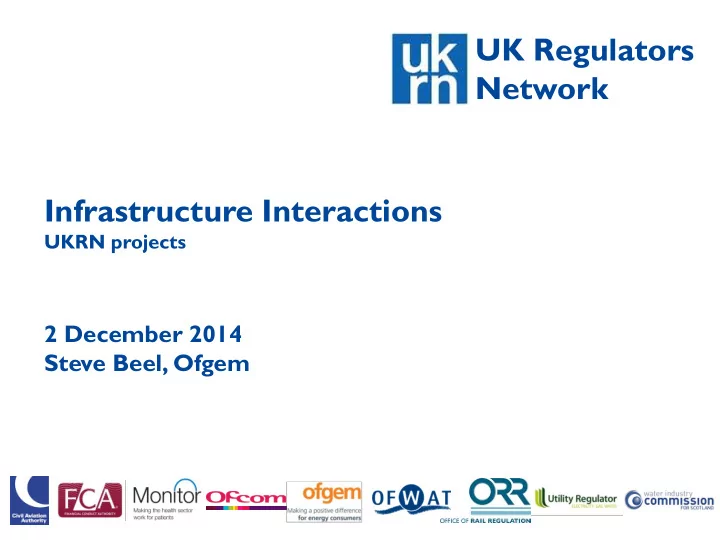

UK Regulators Network Infrastructure Interactions UKRN projects 2 December 2014 Steve Beel, Ofgem
Structure of this presentation • This presentation: • Explains what UKRN is, its interest in infrastructure and the projects UKRN members are leading • Very briefly touches on the role and approach of economic regulation and its relevant to infrastructure investment by utility networks • Outlines two projects – resilience and interactions when installing assets • Contacts: we’re happy to discuss our projects in more detail or hear your views, please contacts: Stephen.Beel@ofgem.gov.uk • • John.holmes@orr.gsi.gov.uk Gurpreet.Sahota@ofcom.org.uk • 2
The UKRN – who we are and what we do UKRN shares best practice and promotes co-ordination between regulators to benefit consumers of essential services • The UKRN was formed in March 2014 – a network of the UK’s independent regulators • It has nine full members: the economic or conduct regulators for the utility industries, transport, health and financial services – key sectors of the UK economy It has two observer members: WICS, LSB • • Its objective is to support regulators to share insights, experience and expertise, to improve the outcomes in those markets or services that UKRN members are responsible for. More on UKRN objectives can be found on its website: http://www.ukrn.org.uk/ • We have a range of projects – undertaken by staff across member regulators – looking at issues of common interest 3
The UKRN’s work on infrastructure issues Over £200 billion will be spent on infrastructure in the UK by 2020 A significant proportion will be in regulated sectors Cross Sector Infrastructure project 2) Processes and 1) Improving investor commercial 3) Supporting and stakeholder arrangements affecting innovations and understanding of the interactions (where a strategic investment regulatory regime project meets in-situ across sectors infrastructure) Two other projects are also relevant: • Resilience of networks – to ensure continuity of supply, recognising the inter- dependencies between network sectors • Affordability for households – recognising that funding for many investments will be recovered through the bills of consumers and business Elements of interdependence exist across all of these project 4
What do economic regulators do that may be relevant to infrastructure? Economic regulators have a focused role, set by statute, with powers aimed at supporting their core functions Economic regulators: key facts • A. Regulators have functions and powers set in statute B. Regulators must exercise their powers to meet objectives and duties set by parliament C. Regulators are independent of government when undertaking their functions, but decisions are subject to legal challenge by affected parties Statutory duties are different for each regulator, but share a common focus to protect the interests of consumers and customers, guiding its policy and actions • Economic regulators: Use price controls as a key tool to ensure monopolies deliver for consumers • • Consider various drivers of investment when considering allowed revenues for network companies for purposes of infrastructure investment Do not make operational decisions for firms – regulators set incentives and • rewards; and some specific obligations e.g. to protect the assets through good financial management, ensure good service levels and compensation arrangements 5
Cross-sector interactions: resilience Utility networks provide essential services: continuity of service is a key objective of network operation and investment • Each regulated sector already has arrangements to review and address risks to continuity of supply: for example The National Security and Emergency Working Group (NSEWG), chaired by DEFRA, is the resilience group focused on the water and sewerage sector • Some regulators have specific duties to ensure regulated firms can maintain services in certain cases, for example gas distribution networks must design their systems to meet ‘1 in 20 winter conditions’ requirement • Our Resilience Project is taking stock of the role and input of economic regulators in this process, and to understand the opportunities / risks of cross-sector interdependence • Ensuring sufficient ‘redundancy’ in a network has a cost Economic regulators can bring a specific perspective: • • Are costs incurred efficiently? What trade-offs in terms of cost and level of resilience are necessary? • • Can stakeholders contribute to deciding the level of resilience and cost? • Who should pay and when? Who is compensated and by how much if service fails? • 6
Cross-sector interactions: installing assets Any new infrastructure assets are likely to disturb in-situ utility assets: the cost of managing these interactions should be efficient • We have been gathering evidence on the experience of interacting with utility network operators (see http://www.ukrn.org.uk/?page_id=182) • The picture is mixed: • Some good practice is reported – focusing on the benefits of early and effective communication and reaching prompt decisions • Some poor practice is reported – delays with design approvals or missed appointments, little transparency on fees, high liabilities or risk transfer to the crossing party • The picture is still incomplete: How serious are the issues? Do they arise often, in every sector, in every sized • project? What is the role of regulation, does it promote or undermine efficient • interactions? • What could be done? What (if anything) prevents industry adopting good practice? • The next phase of our work is focused on addressing these issues 7
Conclusions Economic regulators have a focused role, set by statute, with powers aimed at supporting their core functions, but • Regulators have a role to play: there is significant investment planned in many utility sectors. However, the primary focus for each regulator, driven by statute, is the price and quality of services delivered to those connected to a regulated utility network • Regulators also focus on the incentives (the risks and rewards) facing firms – which must deliver on the need for efficient investment Despite this, regulators are looking cross sector for best practice, lessons and, • where appropriate, opportunities to co-operate with one another, with industry and with existing initiatives across government • Infrastructure investment and installation is a key focus of economic regulators and, through UKRN, are committed to supporting efficient investment 8
Recommend
More recommend